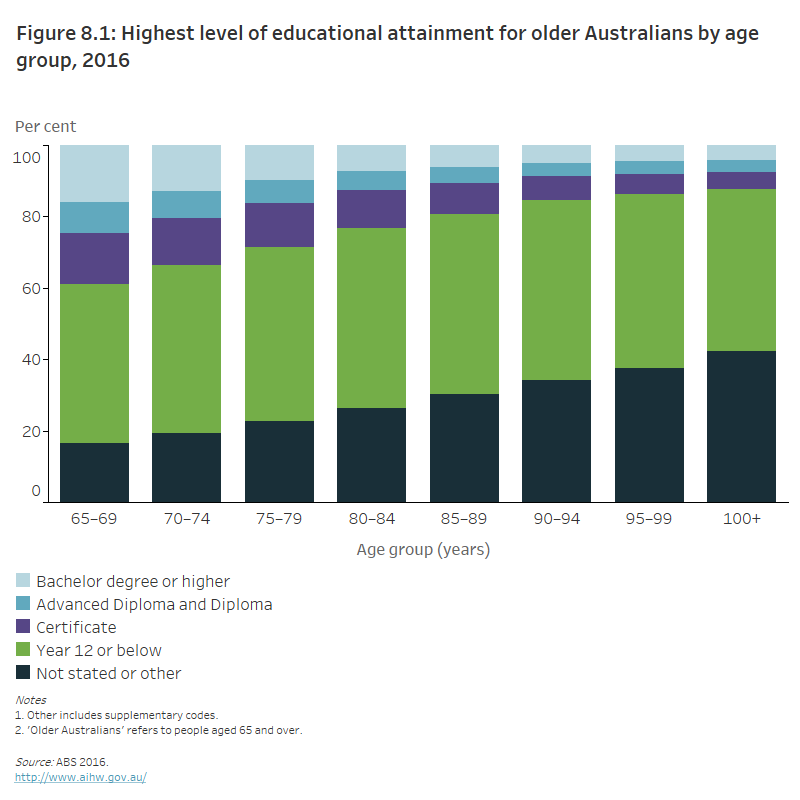Education and skills
Healthy ageing can involve both physical health and social and mental wellbeing. People’s education and skill levels can help maintain mental activity and cognitive functioning in older age. They also impact a person’s life course: the circumstances associated with higher education in mid-life, for example, can continue to offer a protective element into older age. This may be through health literacy and healthy behaviours, or through the employment opportunities and higher incomes associated with higher levels of education (for more information, see Employment and skills and Income and finances).
Older Australians (aged 65 and over) are a diverse population. This diversity is also reflected in the life experiences and skills people have accumulated throughout life.
Throughout this page, ‘older people’ refers to people aged 65 and over. Where this definition does not apply, the age group in focus is specified. The ‘Older Aboriginal and Torres Strait Islander people’ feature article defines older people as aged 50 and over. This definition does not apply to this page, with Indigenous Australians aged 50–64 not included in the information presented.
Highest level of educational attainment
In 2016, almost half (47%) of older Australians had a highest educational qualification of year 12 (or equivalent) or below, while 1 in 5 (19%) had completed a certificate or diploma-level qualification and 1 in 8 (12%) a bachelor degree or higher (ABS 2016).
While the percentage of older Australians whose highest level of educational attainment was Year 12 or below was somewhat similar across age groups, the percentages with higher levels of education varied with age. Generally, those in the younger age groups were more likely to have a qualification at certificate, diploma or degree level than those in the older age groups (Figure 8.1).
Figure 8.1: Highest level of educational attainment for older Australians by age group, 2016
The stacked column graph shows that in 2016 the proportion of older Australians whose highest level of educational attainment was Year 12 or below was somewhat similar across age groups. However, the proportion of people with higher levels of educational attainment, such as a degree, diploma or certificate, decreased with age.

Older Australians’ educational attainment may in part reflect how education would have changed over their lifetime, with degree studies becoming increasingly more common over time. Other factors may also influence what and when people study. For example, of those older women whose highest level of education was a bachelor degree or higher, 30% had studied education and 29% had studied health (compared with 14% and 11% of men, respectively) (Table 8.1).
Table 8.1: Most common fields of study for older Australians whose highest level of education was a bachelor degree or higher, by sex, 2016
|
Sex |
Education % |
Health % |
Society and culture % |
Management and commerce % |
Engineering and related technologies % |
|---|---|---|---|---|---|
|
Men |
13.9 |
11.0 |
20.2 |
18.0 |
15.8 |
|
Women |
30.4 |
29.3 |
21.7 |
6.0 |
0.9 |
|
Total |
21.8 |
19.7 |
20.9 |
12.3 |
8.7 |
Note: 'Older Australians' refers to people aged 65 and over.
Source: AIHW analysis of ABS 2016.
Participation in education and training
In 2016, less than 0.6% of older Australians (almost 21,100) were enrolled in an educational course. Of these, almost one-third (some 6,600) were studying at university or other tertiary institution (AIHW analysis of ABS 2016).
Where do I go for more information?
The page on social support provides information on some other ways that older people participate in Australia’s society.
The ABS publishes information on the education and skills of Australia’s older people through the Census of Population and Housing and the Survey of Education and Work.
References
ABS (Australian Bureau of Statistics) 2016. Microdata: Census of Population and Housing, 2016. ABS cat. no. 2037.0.30.001. AIHW analysis using TableBuilder. Canberra: ABS. Viewed 2020-21.


